Walking the Way from Pamplona to Santiago de Compostela: A Camino Journal
Artsy Traveler contains affiliate links for products and services I personally use and can happily recommend. As an Amazon Associate, I earn from qualifying purchases. Please read the Disclosure for more information. If you make a purchase through these links, at no additional cost to you, Artsy Traveler earns a small commission. Thank you!
Is walking the Camino (walking the way) across northern Spain to Santiago de Compostela on your travel wish list?
Artsy Travelers who Walk the Way will view countless treasures, including the portrait of Mary Magdalene by Leonardo da Vinci in Burgos, tiny medieval churches steeped in history, and soaring architectural wonders, such as the cathedral at León.
Elizabeth Petrie, my friend and an Artsy Traveler guest poster, walked the Camino with her friend, Cheri, and shares her experiences and insights.
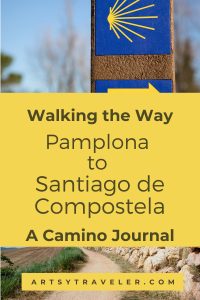
Overview of Walking the Way from Pamplona to Santiago de Compostela Camino Route
Elizabeth and Cheri walked first from Pamplona to Burgos. After a few days sightseeing in Burgos, they took the train to León and then to Lugos.
From Lugos, they rejoined the Way at Sarria and walked the last 120 kilometers to Santiago de Compostela.
Elizabeth shares her experiences and recommendations in three posts on Artsy Traveler.
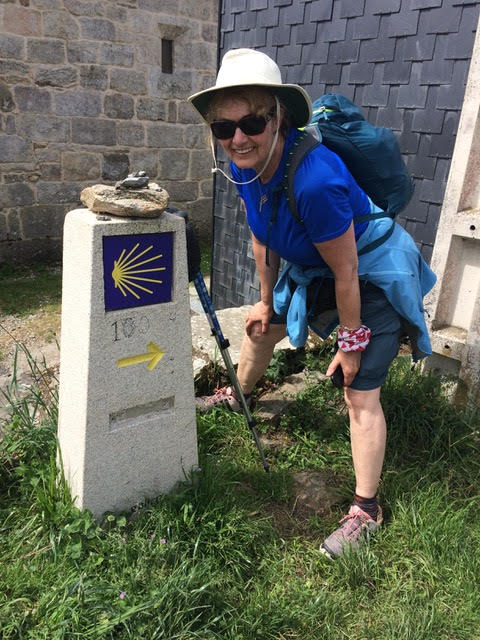
This post includes excerpts from the detailed journal that Elizabeth kept while walking the Way. If you’re interested in walking the Way yourself, read Elizabeth’s recommendations in Top Tips for Walking the Camino to Santiago de Compostela. And for suggestions about what to see and do in beautiful Burgos and León, read Exploring Burgos and León along the Camino of Santiago.
Elizabeth’s lively description of her journey is excerpted from the journal she kept while walking the Way between May 3 and June 1, 2017.
Part 1: Walking the Camino from Pamplona to Burgos
Welcome to Pamplona
The capital of Navarra, Pamplona charms us with its pretty streets, attractive green spaces, and many historical buildings. From our window at the NH Pamplona Hotel, we enjoy a southeast view of a nearby quarry that glows in the evening sun.
A short stroll along the main boulevard brings us to La Cittadella, an old, star-shaped fortress with huge, thick walls. The fortress is situated in a large park through which the Camino passes.
On the day we start our Camino journey, we’ll only need to walk a short distance from our hotel to pick up the trail.
What to See in Pamplona
The central Plaza del Castillo is an attractive public square surrounded by beautiful old buildings. Pamplona is full of monuments, typical in a country with thousands of years of history. All the statues and monuments are well signed and beautifully maintained.
Especially interesting is the large bronze statue depicting the famous “running of the bulls” (el encierro de toros). The portrayal of some unfortunates being trampled or gored by the bulls looks very realistic.
There’s not enough money in the world to convince me to do it, which is just as well since women typically don’t participate.
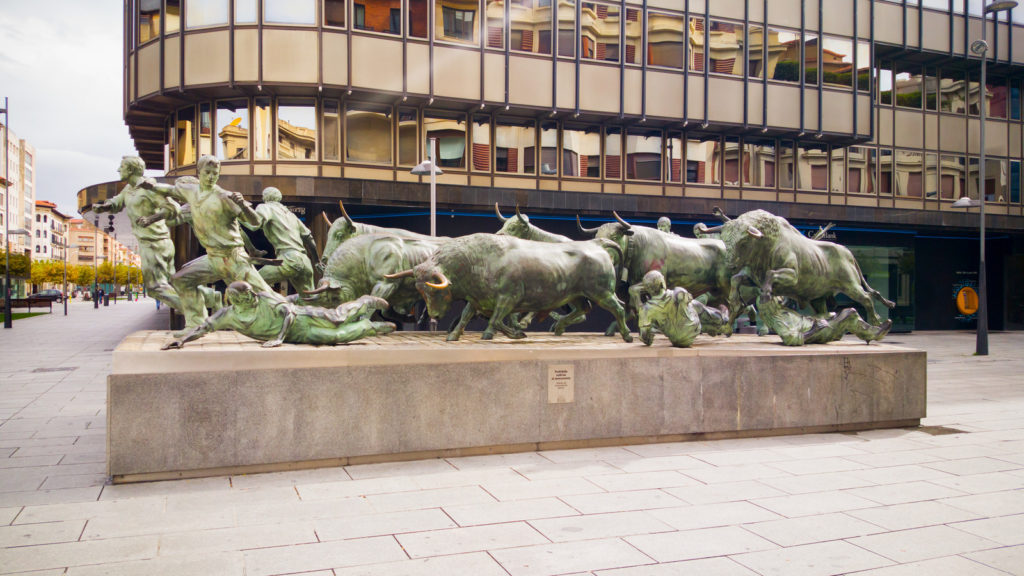
Walking Tour of Pamplona
Consider taking a free walking tour with Free Walking Tour Pamplona. You’ll explore the old town and visit the Gothic Cathedral of Santa Maria, the Plaza del Castillo, and the impressive fortifications that once protected the city. There’s a lot to see in Pamplona!
We’re On Our Way!
At the pilgrims’ albergue in front of the Gothic cathedral, we get our first stamp (estampilla) in our pilgrims’ passports (pasaportes de peregrinos).
We have officially begun walking the way from Pamplona to Santiago de Compostela!
Day 1: Walking the Way from Pamplona to Puente la Reina: 27 kilometers
After three nights in lovely Pamplona, we’re feeling well rested and ready to begin walking the way on our first stretch of the Camino.
Starting Out
As the sun rises in a clear blue sky, we walk through the beautiful grounds of the Universidad de Navarra and out into lovely rolling countryside. Wild poppies are scattered among fields of newly planted crops. We hear birds singing in the fields and hedgerows.
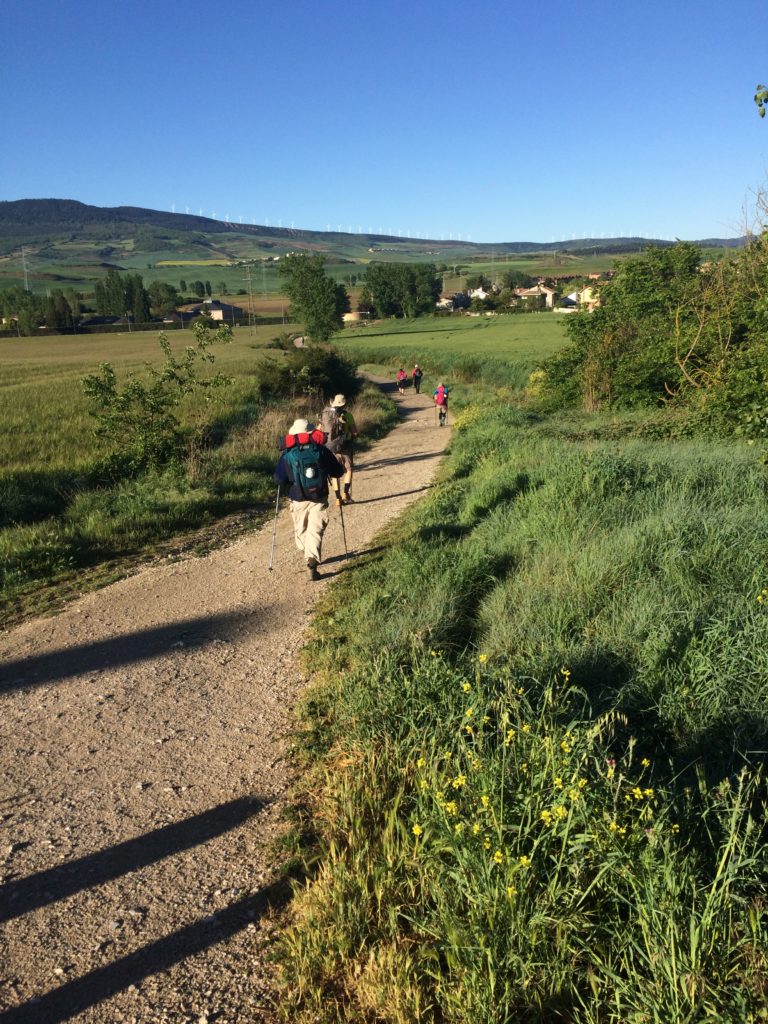
We stop to get a stamp at a private albergue next to the 12th-century Iglesia de San Miguel. The fortified tower of the church was part of the Monasterio de los Hospitalarios de San Juan de Jerusalén.
The knights of the Hospitallers eventually became the Knights of St. John of Malta from which we get the St. John Ambulance service today.
Our First Steep Section
The Alto del Perdón—the first steep section we encounter on the trail—is described in our guidebook as “not as difficult as you will have heard” and is estimated to take “only a half-hour”.
Wrong on both counts!
The trail climbs pretty much straight up—the hardest ascent along the whole Camino. Whenever we start feeling weary, we chant “Alto del Perdón, Alto del Perdón! Nothing is as hard as Alto del Perdón” in rhythm with our steps.
Eventually, we make it to the top where the views are spectacular. Both nearby and in the distance we see one of the many wind farms that take advantage of the strong breezes coming from the Atlantic Ocean and the Bay of Biscay.
Modern metal cut-outs describe the various methods that pilgrims used over the centuries to travel the Camino. One of the inscriptions reads, “where the road of the winds crosses the road of the stars.”
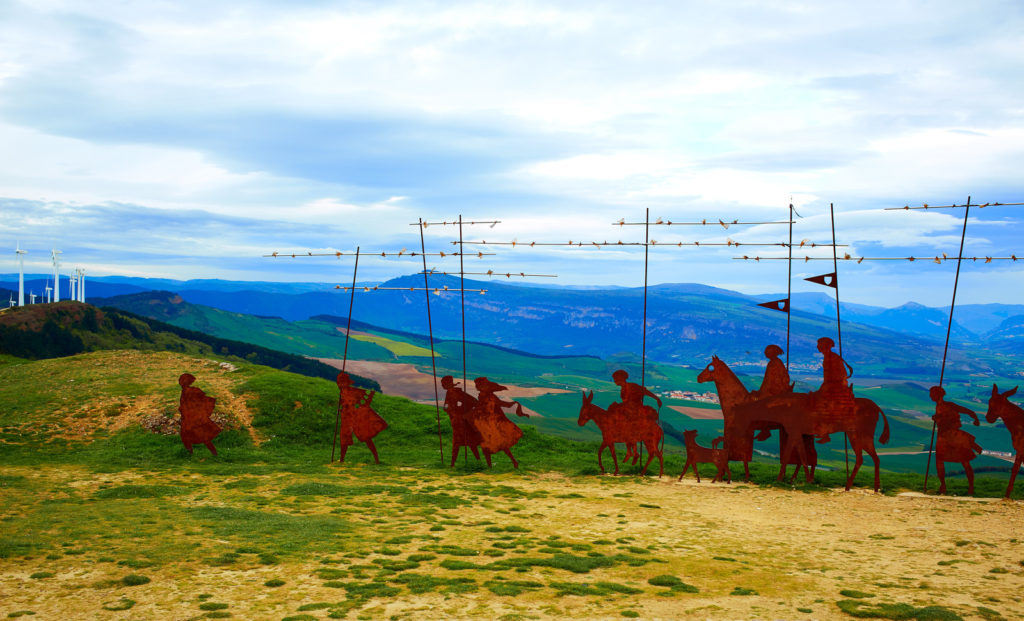
Albergue de Santiago Apóstel in Puente la Reina
At our first albergue, we’re assigned two upper bunks (no ladders!) in a four-bunk room. After a hot shower, we enjoy a pilgrim’s dinner of salad, fish, water, and yogurt, all for just €20, including accommodation.
We’re gratified to have virtually no injuries or aches other than a couple of small blisters. I decide to alternate boots with shoes to avoid putting too much pressure on any one spot on my feet.
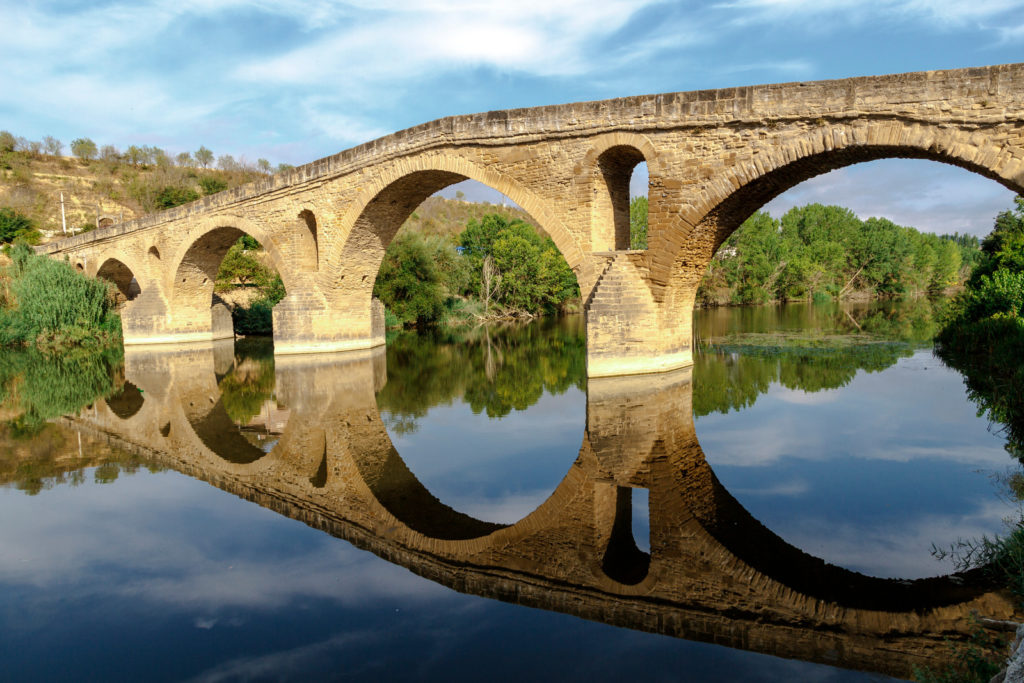
Day 2: Puente la Reina to Ayeguí: 20 kilometers
The next morning, the owner kindly calls ahead to book beds at the albergue in Ayeguí. He also confirms transportation of our packs for only €5 each. Normally, albergues do not take advance reservations. I wonder whether the fact that I speak Spanish helped!
The second day of walking the way is much easier than the first, even with a few strenuous uphill stretches. (Altos del Perdón, Altos del Perdón…). The countryside continues to amaze us with its many crops, flowers, and birdsong. Small lizards sun themselves on the stone walls that mark the route.
Lorca
We stop for coffee in Lorca, a medieval hill town with a wonderful view of the surrounding valley. The route out of Lorca drops very steeply down what is little more than a slippery, rocky gully. After a few more hours of walking, I feel a blister starting on my heel. We decide to take a taxi the rest of the way to Ayeguí.
Enjoying this post? Subscribe to Artsy Traveler to Receive Valuable Travel Tips and Your FREE Guide: 25 Must-Do Artsy Traveler Experiences in Europe for 2025
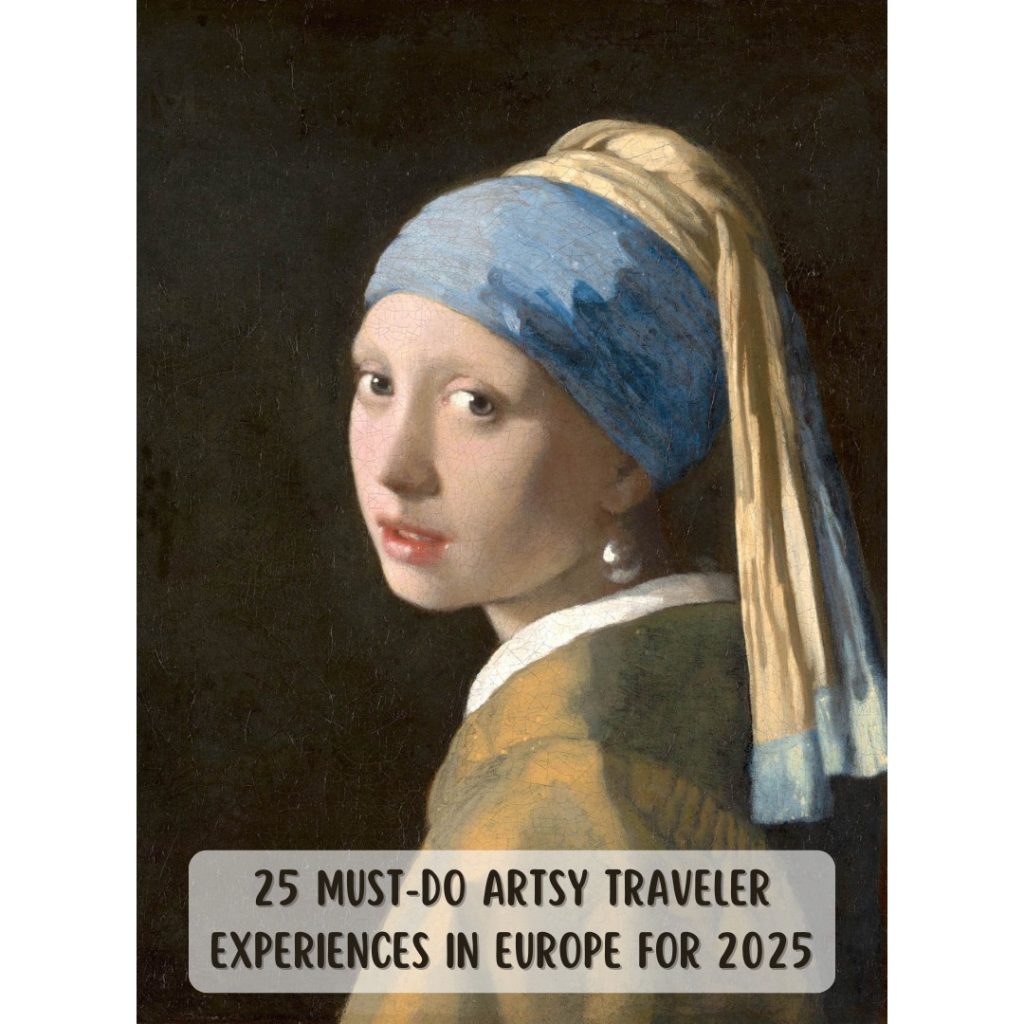
I recommend making occasional use of taxis and public transport to save your feet. A small blister can become a large one very quickly and make walking agony.
Day 3: Ayeguí to Torres del Río: 27 kilometers
Our third day walking the way is a long one! We take a break in Irache, where a fountain with a dual spigot offers both water and wine. We fill our water bottles from one and take a sip from the other.
The sign on the fountain reads Pilgrim! If you wish to arrive in Santiago full of strength and vigour, just take a drop of this great wine and jump for joy. Another sign notes We invite you to enjoy in moderation; if you wish to take some wine along, you will have to buy it!
The Camino winds past numerous churches and historical buildings—too many to count and, unfortunately, too many to visit. Many are Romanesque in style, reminding us again of the extent of the Roman Empire at its height.
Sometimes, we walk at the side of the local highway and at other times on gravel paths dating from ancient times. The Way between Villamayor de Monjardín and Los Arcos typifies the Camino.
It’s a long, narrow road stretching into the distance between open fields, with very little shade and no place to fill our water bottles.
Los Arcos
Arriving in Los Arcos is a relief for our feet and our thirsty throats. It’s a beautiful old town that has been inhabited since Roman times. The Iglesia de Santa María has a mixture of architectural styles (Romanesque, Gothic, and Baroque), and the series of arches along the walls of the original cloisters gives the town its name.
Los Arcos is a popular stopping point, but we decide to continue another six kilometers to Torres del Río. Hmm…perhaps not the best idea, as it turns out! The weather has warmed considerably, and there’s not a breath of wind. We sing, make lists of places we’d like to go someday, and generally distract ourselves from the trudge.
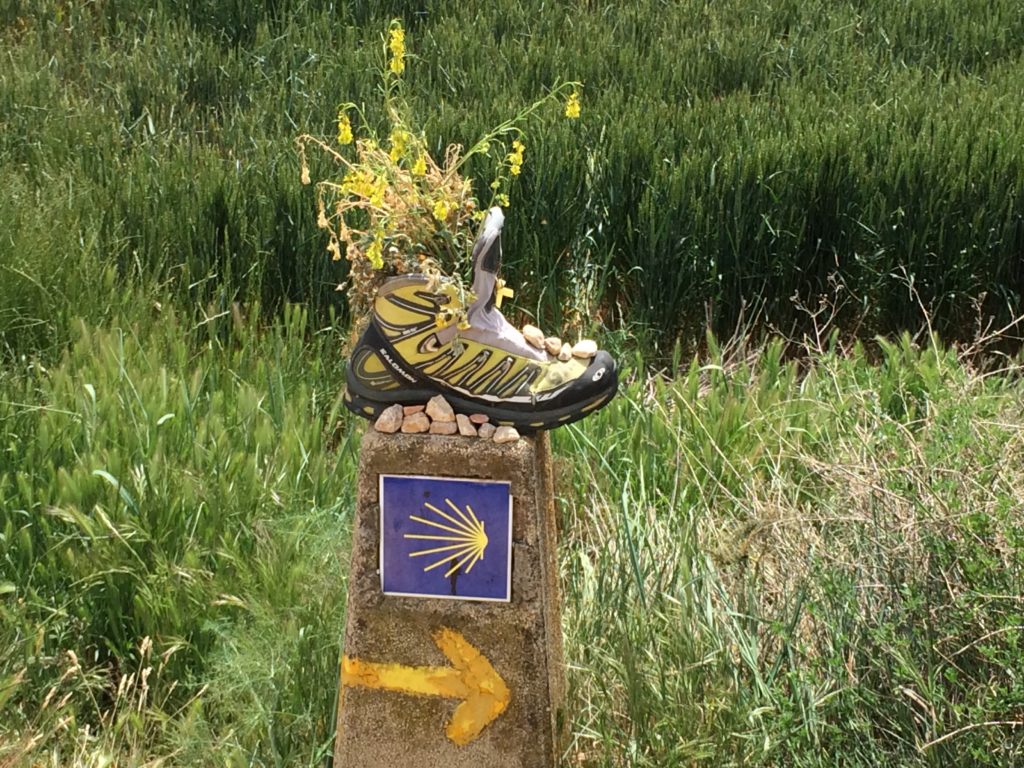
Finally, we arrive at the delightful little town of Sansol and take a taxi to Albergue La Pata de Oca at Torres del Río. What a treat! The main building is hundreds of years old, with thick stone walls and solid beams in the ceilings, all covered with plaster.
Our private room is upstairs under the rafters. The ceiling slopes so much that we have to stoop to open the window. The patio is lovely, with lots of flower pots filled with bright red geraniums.
We enjoy a delicious dinner of bean and chorizo soup, chicken, flan, and wine. After a long, hot day, we collapse into bed about 9:15.
Day 4: Torres del Río to Ventosa: 4 kilometers
We decide to take it easy after yesterday’s long walk and opt for a later start and a shorter walk with a taxi ride in between.
While relaxing over breakfast on the terrace, we meet Ian from Ireland. He tells us that he’s a former addict who has been clean for 26 years and has adopted his nephews (one of whom is on the autism spectrum) after the death of their parents.
Encounters with people like Ian and others from all over the world and with a variety of backgrounds is one of the most enjoyable aspects of our journey.
Before starting our walk, we visit the Romanesque Church of the Holy Sepulchre across the street from the albergue. Dating from the 12th century, the small, octagon-shaped church was founded by the Knights Templar during the time of the Crusades.
The dome’s ribbing forms the outline of an eight-sided star, typical of Moorish Spain. The 13th-century crucifix depicts Christ’s feet separately rather than crossed one over the other as is typical.
Day 5: Logroño to Ventosa: 21 kilometers
We stop for lunch in Navarrete, an attractive hill town with narrow cobblestoned streets leading to the town plaza. A small church–La Iglesia de la Asunción–doesn’t look particularly special from the outside. We almost don’t go in. Luckily, we did and found one of the most amazing Baroque retablos (altarpieces) in all of Spain.
Our albergue in the tiny village of Ventosa has a typical set-up, with ten bunks to the room, plenty of hot water and many modern conveniences. Again, our pilgrims’ meal is delicious and very reasonably priced. For €10, we dine on paella with chorizo along with salad and a beer.
Day 6: Ventosa to Nájera to Santo Domingo de la Calzada: 5 kilometers
Cheri’s blister and ankle are acting up, so we take a taxi and then a local bus to Santo Domingo where we stop for the night.
A rooster motif is everywhere in Santo Domingo, reflecting the legend of how a young man had been wrongly accused and executed for theft.
One version recounts that his parents had seen a vision of St. Dominic holding their son up alive. When they rushed to the magistrate to report this miracle, the judge laughed and said that the boy was as dead as the rooster and chicken on his plate. At that, the birds came alive and fluttered about the room, thereby “proving” that the young man was innocent.
To this day, a pen inside the cathedral holds a rooster and a hen (different ones every two weeks). It’s a sign of good luck if you hear the rooster crow.
Day 7: Santo Domingo de la Calzada to Belorado: 21 kilometers
On a day of mixed sun and cloud, we pass through the town of Viloria de Rioja, the birthplace of St. Dominic and from there into the province of Castilla y León.
At the albergue in the evening, we enjoy our €10 pilgrims’ dinner of two courses and wine and chat with Marcelo from Argentina and David from San Sebastián. Our pleasant conversation covers everything from politics, to films, to the various people we’ve met on the Way, to our common love of travel and adventure.
Day 8: Belorado to Cardeñuelo Río Pico: 9 kilometers
We carry our big packs today and find that after more than a week of walking the way on the Camino, we’re getting stronger.
The Albergue Santa Fe in Cardiñuela where we stop for the night has just one double room left, complete with a private bath, towels, soap and shower gel, and a television. With the pilgrims’ dinner included, the cost is about €55 each—another example of the excellent travel bargains to be found on the Camino.
Day 9: Cardeñuela Río Pico to Burgos: 17 kilometers
A strong, cool breeze in the morning makes for good walking weather. As we approach Burgos, we pass through several prosperous-looking neighbourhoods which likely are bedroom communities of the city itself.
The Camino enters Burgos via a pretty walk along the river. When we finally reach the center of town, we take a taxi to the AC Hotel which is perfectly situated about two blocks from the central plaza and the cathedral.
We enjoy tapas at one of the outdoor cafés in the colonnaded central plaza.
Part Two: Walking the Way from Sarria to Santiago de Compostela
Days 10 to 14: For the next several days, Elizabeth and Cheri tour Burgos and then León. Read Elizabeth’s suggestions about what to see there in the post Exploring Burgos and León.
Day 15: Samos to Sarria: 21 kilometers
After several days exploring Burgos, León , and Lugos (see Exploring Burgos and León ), we take the train to Sarria, drop off our packs at the albergue La Casona de Sarria and then take a taxi to Samos to explore the Benedictine Monastery.
Wow! The Benedictine monastery at Samos is stunning, with some sections dating back to the 6th century.
Currently, only eight monks and two novices are in residence, with some of the original monks’ cells now serving as simple accommodations for people participating in organized religious retreats.
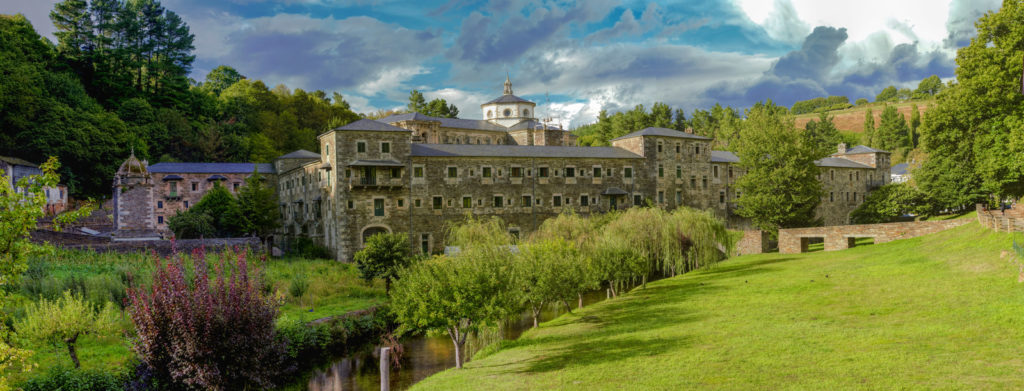
The interior cloister at the monastery is the largest in Spain, and some of the walls display original frescoes.
Back on the Camino: Samos to Sarria
After a quick lunch, we resume walking after our days off for sightseeing in Burgos, León , and Lugo. We set off back to Sarria, a walk of about twelve kilometers and one of the most beautiful stages of our journey.
The route starts behind the monastery, winds past the kitchen gardens and along cool shaded paths alongside a small river, with some ascents and some descents but few signs of modern habitation. We pass a couple of 12th-century wayside chapels, small abandoned houses, wooden bridges, and old slate drystone walls.
You can almost imagine yourself a thousand miles from any center of population and thousands of years back in time.
One farmer is repairing his drystone slate wall and lets us fill our water bottles from his well. We stop a bit farther on for a cold drink in a typical taberna do Camino.
Day 16: Sarria to Portomarín: 24 kilometers
We start our day by crossing the old Roman bridge just down from the albergue. The stela marker informs us that we are 113 kilometers from Santiago.
At this point of our walk, we’re encountering many more people on the Camino, particularly Europeans taking a week to do the minimum journey (100 kilometers).
To receive the completion compostela in Santiago, pilgrims must present their passports bearing at least two stamps per day for the final 100 kilometers.
As we’ve come to expect, the countryside is absolutely beautiful, with rolling hills, manageable ascents, and plenty of lush vegetation providing shade in the increasingly hot weather.
This region is quite well watered by rain, and there are lots more dairy cattle and other livestock grazing in green pastures.
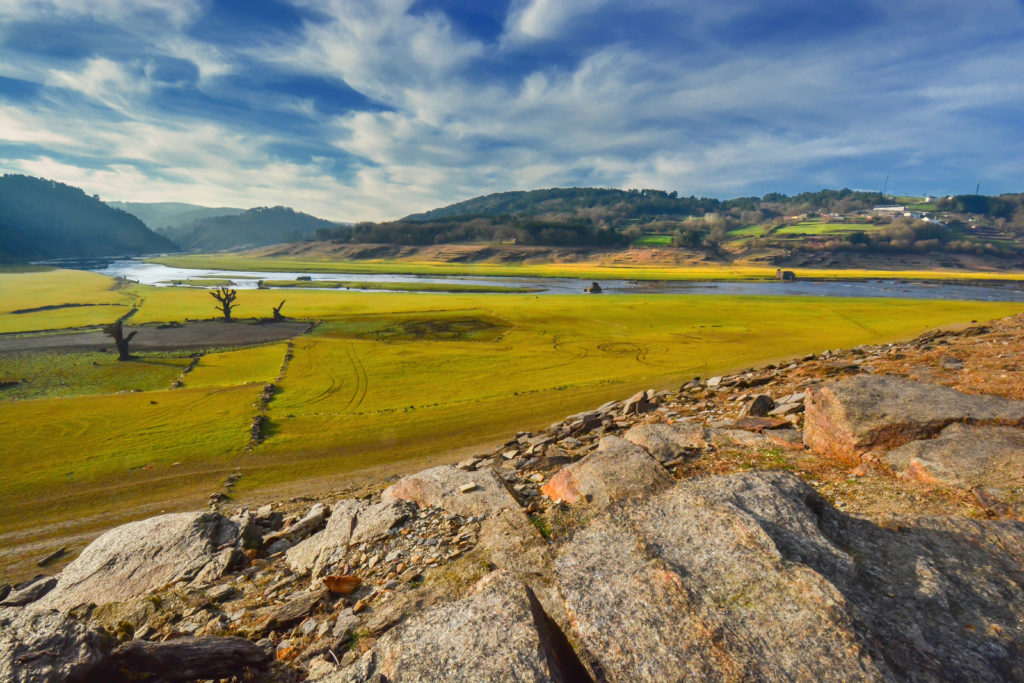
At one short rest stop, we listen to a piper in Galician dress—a reminder of the strong Celtic influence in this part of Spain. Much of the day’s route follows the old Roman road, with some of the original Roman stone walls still marking out different pastures.
A very old church marks the beginning of the final 100 kilometers to Santiago.
Day 17: Portomarín to Palas de Rei: 26 kilometers
Today’s route includes ups and downs through rolling and beautiful countryside. We’re starting to become blasé about the medieval churches. Ho hum, 14th century.
We find a fair bit of traffic along the Camino and several small tour groups.
Part of the Camino passes through thick stands of eucalyptus trees, originally imported from Australia. The scent of the leaves that have fallen to the ground and crushed by passing feet is delightful.
Day 18: Palas de Rei to Melide to Arzúa: 17 kilometers
Despite the heat, we enjoy a good night’s sleep followed by an excellent breakfast.
In a small chapel along the route, I’m fascinated by a poster of a stunning Madonna and Child (Mater Divinae Providentiae) painted by Scipione Pulzone da Gaeta in the mid-16th century.
I’ve never seen a Madonna which so tenderly expresses the love of mother for child. How different from the usual dreamy, remote images of Mary and the baby Jesus. This one is all about maternal love and one of the loveliest I’ve ever seen. I’ve never heard of this artist, and I plan to learn more about him.
The Camino from Melide to Arzúa is not a difficult stage, but it does have ascents and descents virtually the entire way. Fortunately, the many groves of fragrant conifers and eucalyptus trees along the path are very pleasant and make the steeper inclines much more manageable.
The official markers remind us that we’re getting closer to our final destination.
Later this afternoon, I suffer the only mishap of the entire trip when I stumble into a patch of nettles. Ouch! But Cheri quickly pulls out the antihistamine tablets and After Bite lotion, and, almost immediately, the rash subsides and the itch disappears.
Day 19: Arzúa to Pedrouzo: 22 kilometers
Our water and energy drinks at the ready, we set off early before the heat sets in and make pretty good time, even on the up and down stretches. The crowds are certainly growing.
At one stop, we purchase coffee, bananas, and small concha patches sold on the honor system/por donativo. Next to the building is a “wall of wisdom” (muro de la sabiduría) containing interesting quotes and reflections on travel.
I’m sure the quotes keep conversation going among the pilgrims as they near the end of a long journey.
An interesting feature of the places we pass are the corn cribs—large covered storage areas on stilts. The walls are perforated to allow air circulation but not rodents, and their height prevents livestock from investigating too closely and knocking them over.
Day 20: Pedrouzo to Santiago de Compostela: 22 kilometers
Our last day of walking the Camino!
We’re up and away before sunrise on what promises to be another warm day. The crowds have become thick, and we sometimes have to jostle for room to manoeuvre around groups.
Approaching Santiago de Compostela, the Camino skirts the northern end of the airport, which is clean and modern. We encounter a couple more steep spots, and then, suddenly, we’ve reached the official city limits of Santiago.
To enter the city proper, we cross a rickety plank footbridge into a semi-residential area and up into the original medieval town. We descend a flight of stairs, walk through a large portal set into very thick stone walls, and enter the central plaza of Santiago de Compostela.
The scaffold-covered cathedral looms into the rapidly clouding sky. We’ve made it!
We head to the new tourist center to get our official completion credential. There’s a long queue, and for a while we wait outside in the patio area.
Almost immediately after we enter the building, a big thunderstorm breaks, rain teeming down on the poor folks still out walking on the Camino or waiting outside to get their final stamp.
Arrival in Santiago de Compostela
We celebrate our achievement with an empanada and beer in the restaurant of the Santiago Parador—a former hospital founded by Ferdinand and Isabella in the 1490s.
We enjoy a deep, restful sleep, despite the thunderstorms. By mid-morning, the weather has cleared, and we return to the cathedral and tour the adjacent museum, timing it so that we can enter the cathedral itself from the cloister.
Visit to the Cathedral of Santiago
The entrance to the cathedral closes at 11:45 in preparation for the Pilgrims’ Mass, and by 11:15, it’s already filling up. We snag a spot on a small ledge at the base of one of the huge pillars near the back and have a reasonably good view.
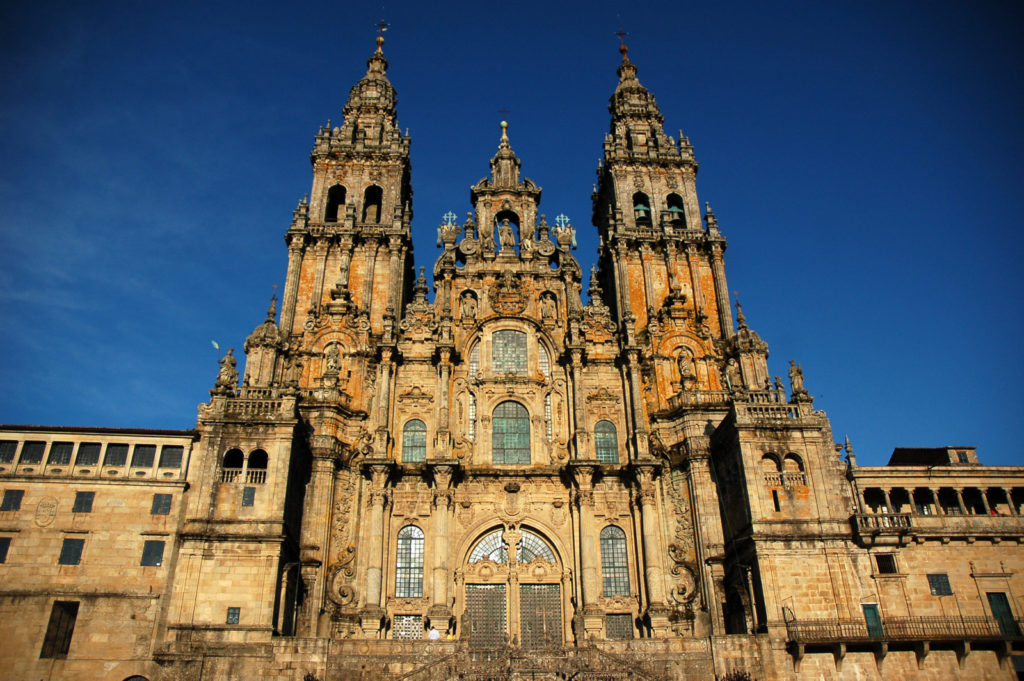
The service starts, and the nun leading the chants and responses has the most glorious voice. We recognize many of the service prayers, even though they are in Spanish: the collect, the Lord’s Prayer, the reading from the Old and New Testaments (Corinthians and John), the general confession, and so on.
The highlight of the service, and the reason that many people are there, is the swinging of the enormous censer across the transept.
At least five or six deacons or lay brothers manoeuvre it into place and set it swinging, and the sweep of its pendulum action gets higher and higher. Ropes and pulleys are affixed to the ceiling, and the angle of the swing is maybe 120° or more.
After the service, people line up behind the main altar to hug a plaster statue of St. James. Meanwhile, there are practically no people lined up to descend to the crypt to see St. James’ ossuary, an amazing chest of embossed silver.
If the bones of the saint are really contained within, it’s interesting to think that here was someone who actually knew Christ.
Back at the hotel after a bit of shopping, we calculate the distance we’ve walked. From our first day of walking on May 6 to our final day in Santiago de Compostela on May 26, we logged 338 kilometers!
Conclusion
Would I do the Camino again? Absolutely! Do I recommend it to anyone who is reasonably fit and looking for an adventure? Of course!
Something magical happens when you slow down to tread in the footsteps of the thousands of pilgrims who have walked the Way.
You hear birdsong, feel the sun warm your face, view stunning landscapes steeped in history, enjoy wonderful food, and meet people from all over the world.
The Camino beckoned and I’m very glad I followed.
For more on the Camino, read Elizabeth’s recommendations in Top Tips for Walking the Camino to Santiago de Compostela. And for suggestions about what to see and do in beautiful Burgos and León, read Exploring Burgos and León along the Camino of Santiago.
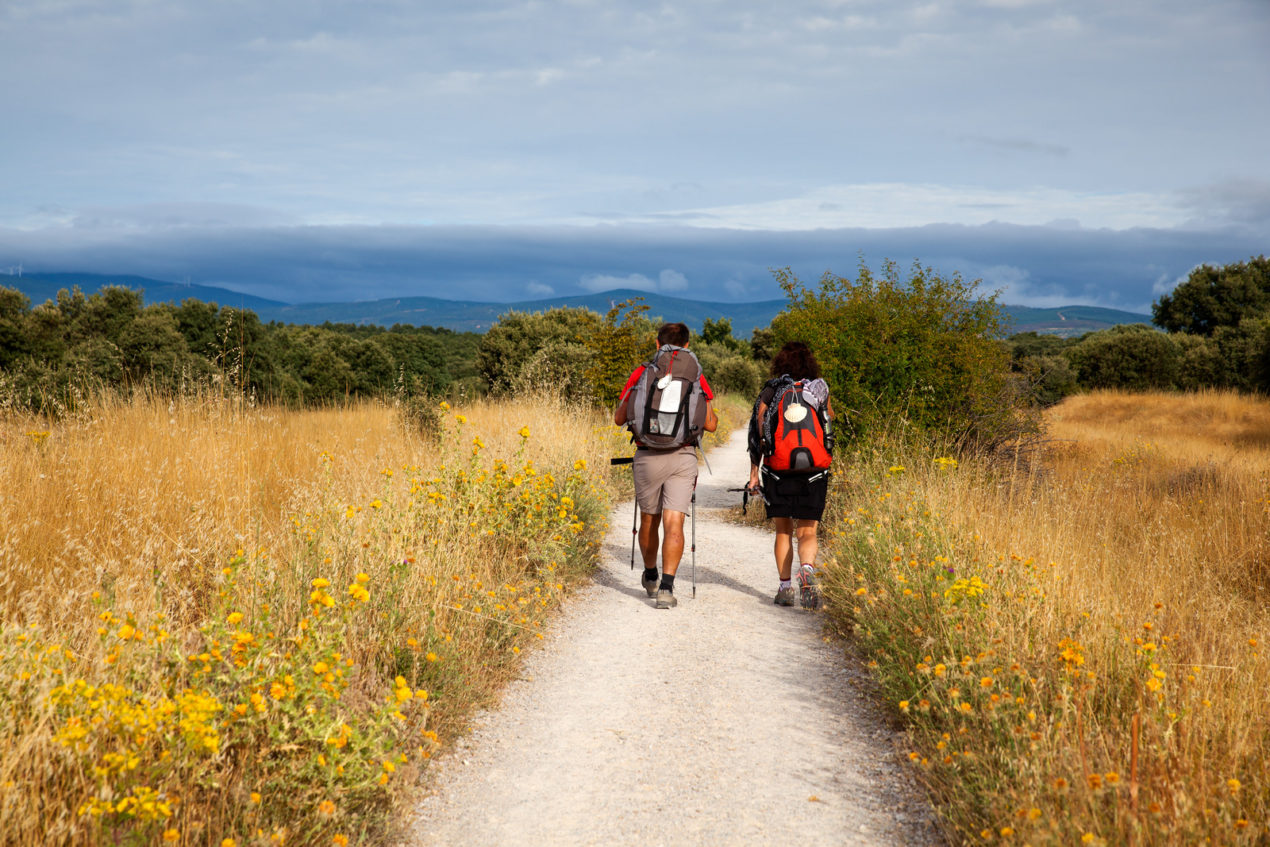
I enjoyed your writing! I have visited The Way with a small group including Carolyn Myss in 2018. It wet my appetite.
I’m in the process of planning a return.
Thank you for your words🙏